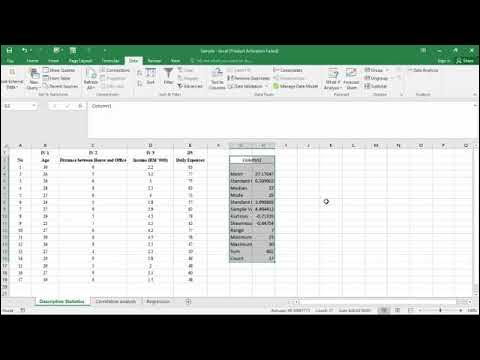STATISTICA parte 2.3 : correlazione e regressione
Summary
TLDRThis video is the final part of a three-part series on statistics, focusing on correlation and regression. The content covers the relationship between two quantitative variables, explaining concepts like covariance, correlation coefficient, and regression line. The video demonstrates how to calculate covariance and correlation using examples from supermarkets and businesses, exploring the strength of linear relationships. It also introduces the concept of linear regression and how to interpret and predict trends based on data. The video concludes with exercises and practical tips for calculating and applying these statistical methods.
Takeaways
- 😀 The video is part of a three-part series on statistics, focusing on correlation and regression.
- 😀 The professor explains correlation as the relationship between two quantitative variables, contrasting it with qualitative variables discussed in previous videos.
- 😀 Covariance is introduced as the statistical index used to measure correlation between two variables. It can be positive, negative, or zero depending on the relationship between the variables.
- 😀 The professor demonstrates how to visualize covariance geometrically using a scatter plot with a 'cloud' of points. A positive covariance indicates an upward trend, while a negative covariance shows a downward trend.
- 😀 A covariance of zero indicates no linear relationship between the variables, and the points are scattered without any regularity.
- 😀 The concept of the coefficient of linear correlation (r) is introduced, calculated as the covariance divided by the product of the standard deviations of both variables.
- 😀 The video emphasizes that a correlation coefficient close to 1 indicates a strong linear relationship, while a value close to 0 suggests no linear relationship.
- 😀 The professor walks through examples, including calculating the correlation coefficient between supermarket data (surface area and weekly revenue). A correlation coefficient of 0.93 indicates a strong linear relationship.
- 😀 The professor also explains how to calculate the regression line and its slope using covariance and standard deviations, and shows how the regression line can be used for extrapolation and predictions.
- 😀 The video concludes by explaining how the goodness of fit of the regression model is assessed using the coefficient of determination, calculated as the square of the correlation coefficient (r²).
Q & A
What is the main focus of the video?
-The main focus of the video is to explain the statistical concepts of correlation and regression, specifically dealing with quantitative variables and their relationships.
What is the difference between qualitative and quantitative variables in statistics?
-Qualitative variables are categorical (such as colors or types), while quantitative variables are numerical and can be measured and counted (such as weight, height, or sales).
What is covariance, and how is it represented?
-Covariance is a statistical measure of the relationship between two quantitative variables. It indicates whether the variables tend to increase or decrease together. It is represented by the formula 'cov(X, Y)', where X and Y are the variables.
How does the geometric interpretation of covariance help in understanding its meaning?
-Geometrically, covariance can be understood by plotting the data points on a Cartesian plane. A positive covariance indicates that the data points move in the same direction, a negative covariance indicates the opposite, and zero covariance suggests no predictable pattern.
What does a positive covariance indicate?
-A positive covariance indicates a direct relationship between the two variables, meaning as one variable increases, the other also tends to increase.
What does a negative covariance indicate?
-A negative covariance indicates an inverse relationship between the two variables, meaning as one variable increases, the other tends to decrease.
What is the linear correlation coefficient (r), and how is it calculated?
-The linear correlation coefficient (r) is a measure of the strength and direction of the linear relationship between two variables. It is calculated by dividing the covariance of the variables by the product of their standard deviations.
What does the correlation coefficient value tell us about the relationship between two variables?
-The correlation coefficient value (r) ranges from -1 to 1. A value close to 1 indicates a strong positive linear relationship, a value close to -1 indicates a strong negative linear relationship, and a value near 0 suggests no linear relationship.
How is the concept of regression introduced in the video?
-Regression is introduced as a method to express one variable as a function of another. In the case of linear regression, it involves determining the line that best fits the data points, typically using the formula for the line y = mx + b.
What is the purpose of calculating the coefficient of determination (R^2)?
-The coefficient of determination (R^2) measures the goodness of fit of the regression model. It indicates how well the regression line explains the variation in the dependent variable.
Outlines

Dieser Bereich ist nur für Premium-Benutzer verfügbar. Bitte führen Sie ein Upgrade durch, um auf diesen Abschnitt zuzugreifen.
Upgrade durchführenMindmap

Dieser Bereich ist nur für Premium-Benutzer verfügbar. Bitte führen Sie ein Upgrade durch, um auf diesen Abschnitt zuzugreifen.
Upgrade durchführenKeywords

Dieser Bereich ist nur für Premium-Benutzer verfügbar. Bitte führen Sie ein Upgrade durch, um auf diesen Abschnitt zuzugreifen.
Upgrade durchführenHighlights

Dieser Bereich ist nur für Premium-Benutzer verfügbar. Bitte führen Sie ein Upgrade durch, um auf diesen Abschnitt zuzugreifen.
Upgrade durchführenTranscripts

Dieser Bereich ist nur für Premium-Benutzer verfügbar. Bitte führen Sie ein Upgrade durch, um auf diesen Abschnitt zuzugreifen.
Upgrade durchführenWeitere ähnliche Videos ansehen
5.0 / 5 (0 votes)






